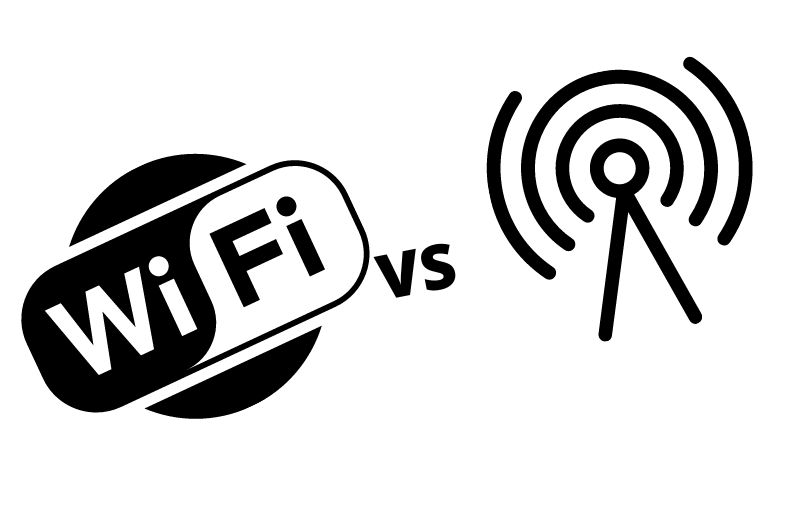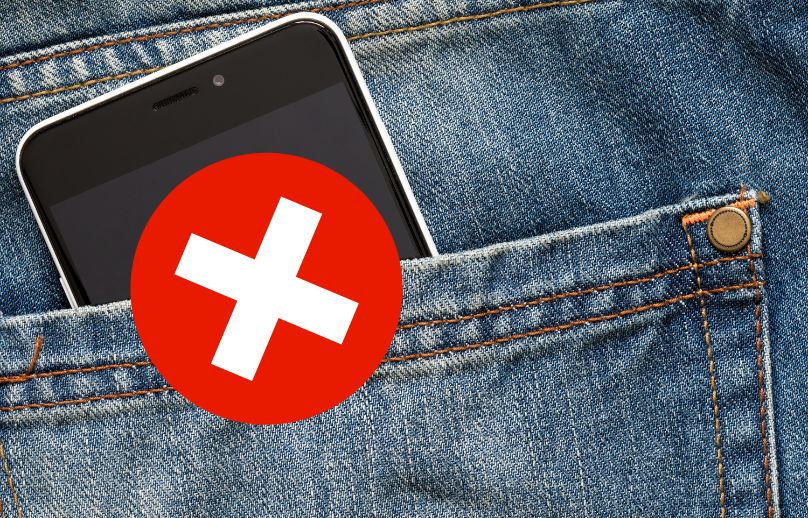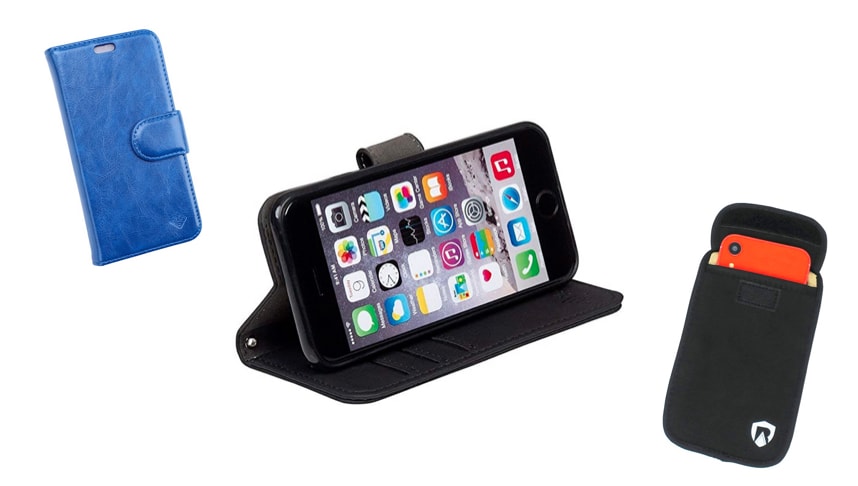Is there 5G in my city? Is there 5G cell towers near me or my business? You are definitely not the only one asking these questions.
There is a growing movement of concern over 5G network towers and their safety and affect on the environment, causing a lot of fear over whether these towers are close to your home.
Untested 5G Technology
Your concern is warranted. The 5G rollout is untested and under researched technology is being put out around the world and some are claiming that we are the guinea pigs for this technological experiment. Understandably, you want to know where these towers are located.
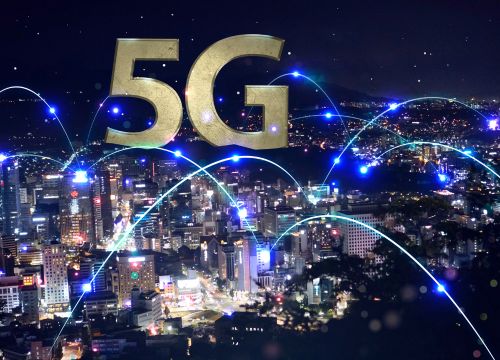
- Untested 5G Technology
- Mini Towers
- Camouflage Towers
- Locating Cell Towers Near Me
- Determining If 5G Is in Your Area
- 5G Towers In Your Neighborhood
- AT&T 5G Cell Phone Tower Locations Near Me
- Verizon 5G Towers Near Me
- Sprint 5G
- Maps that Show the Nearest Towers
- Websites With Cell Phone Tower Locations
- The Role of Smartphone Apps To Find 5G Networks
- Your Cell Phone as a Locator
- Monitoring 5G Growth
- How to Prepare For 5G Cell Towers Near Me
- Wrapping It Up
- References
Mini Towers
Did you know that with the advanced technology, mini cell towers now exist, and they are actually being hidden in trees, on lamp posts, street lights, rooftops, etc.? They can be the size of a pizza box and are therefore really hard to locate.
Camouflage Towers
Some cities (like Baltimore or Arvada, Colorado) are requiring communication companies to camouflage or disguise the phone towers they are installing, hoping they will ‘blend in’ with the surrounding natural environment.
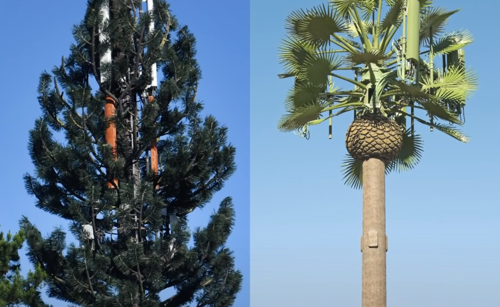
So it’s up to you to find these towers yourself, and unfortunately it’s not the easiest process you can’t just Google it and see it in the search results.
So I’ve written this guide to offer you different ways to locate towers near you.
Since this is the next technological standard and over the coming 10 years, most carriers will have switched from 4G, you’ll also want to keep an eye on the spread of 5G, because if it’s not near you now, it likely will be soon.
Locating Cell Towers Near Me
So how do you find 5g towers near you? As I mentioned above, finding these cell towers isn’t as straightforward as you’d think.
Many of the more popular sites with cell tower maps don’t yet include 5G – hopefully soon they will which will it all more transparent for all of us but for now you’re going to have to do a little more work.

You only need a computer, laptop or device that has an internet connection.
Determining If 5G Is in Your Area
The first thing I recommend you do to find these cell towers is to go to this page and check the Ookla 5G map. This interactive map is straightforward, easy to use, and also free. You don’t have to fill out a form, create an account with your name and email either.
It is updated weekly and shows you towers around the entire world. You can also follow the map on social media to get alerts on updates, if you don’t want to keep checking their site.
Ookla 5G Cell Tower Map
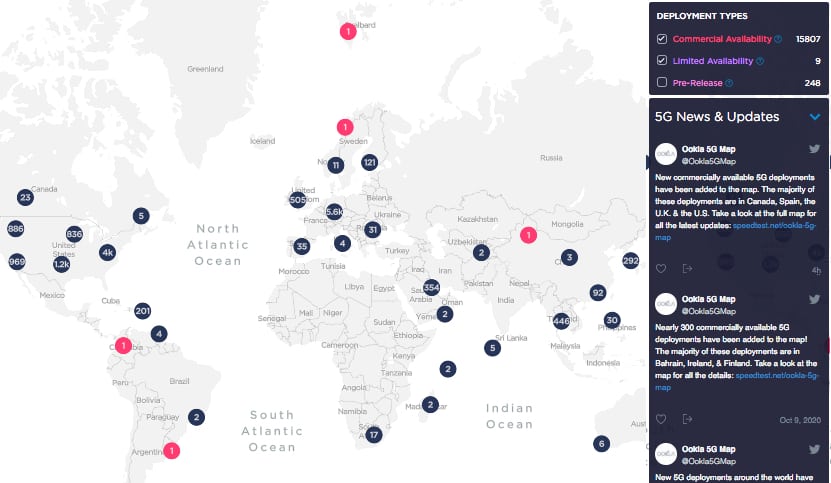
You have the option to filter by deployment type. There are three check boxes you can use to search, including:
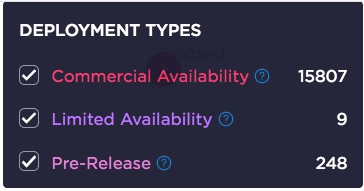
1. Commercial Availability means a 5G is prevent and devices are available for consumers to purchase and use.
2. Limited Availability means a 5G network is present but is limited to select consumers.
3. Pre-Release means 5G hardware is in place but is currently in testing and/or not yet accessible to consumers.
I recommend you search for all three, and zoom in to your city or region to see if any are there yet, it would be nice if you could search by zip code but that feature isn’t available. Even if there isn’t currently commercial availability in your area, it’s good to know if a tower will be active near you soon.
The different availability of 5G are shown in color-coded circles (dark blue-commercial, red-limited, and pink-pre release) with numbers indicating how many carriers are offering 5G services in that location.
Cellular Maps
Another option I recommend is CellularMaps.com 5G Wireless Coverage. This site shows you several different 5G maps, broken down by carrier.
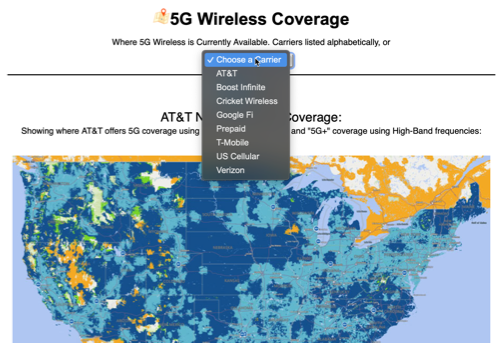
It also distinguishes between low and high band signals (otherwise known as millimeter). This will give you an idea of what to look for when you are looking for a specific cell tower location.
Low band infrastructure look like your more typical large towers, easy to identify, while high band towers are the small hidden ones I mentioned earlier.
High band signals can only travel short distances, requiring lots of small cell towers to be built in one area. These are the tricky hidden pizza boxes you’re going to have to really look for.
Use a combination of both Ookla and Cellular Maps to get the best picture of what is going on in your area regarding 5G.
5G Towers In Your Neighborhood
Hopefully you have not found any towers near you and all you have to do is keep watching for future development.
If that is not the case, and you have found 5G in your area, then you’ll want to find the towers or at least find out if they are in your neighborhood.
Millimeter Towers

Now you will be trying to find the millimeter towers (these are the small ones that can be hidden). There are concerns for all towers, particularly the 5G, but it is the millimeter frequency ones that people and experts alike are most concerned about.
These towers emit much higher frequencies than low and mid-band (like 3G and 4G) that haven’t been properly researched.
Harder To Find
Because of the difference in frequency, these particular cell towers are much harder to find (never mind their small size and the fact that they are deliberately being hidden).
Conventional EMF meters will not work to find them. You’ll need a meter that can read frequencies between 24 and 39 GHz.
Best Meter To Find Them
Currently, the best meter for this range is the Anritsu’s Field Master Pro but that’s just one example. It is a spectrum analyzer that can detect frequencies between 9KHz and 54GHz.
However, if you cannot buy a spectrum analyzer, you can rely on data from network providers that offer high band 5G. There are only a handful that do.
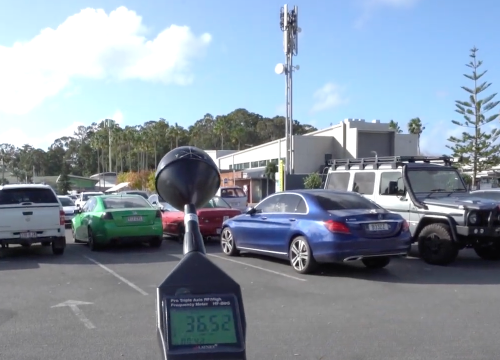
Since T-Mobile is currently focusing on low band towers and Sprint is using mid-band frequencies, the providers to keep an eye on are AT&T and Verizon – if you’re in the United States. If you live in other countries then you’ll want to check out Ookla for the providers using 5G.
AT&T 5G Cell Phone Tower Locations Near Me
AT&T offers 5G in 21 cities within 12 states in the US. Unfortunately, their website does not have a solid 5G coverage map.
They only have a map that shows the cities they currently have 5G in. You can find a more detailed AT&T coverage map on Cellular Map’s site, but it’s still not at a neighborhood level.
Using Ookla, you’ll be able to see where the towers are located if you zoom in as close as you can. This still won’t show exactly where they’re located but it’ll tell you which neighborhood blocks have coverage.
If you live within one of these blocks, or close to one then you definitely have a tower near you.

Verizon 5G Towers Near Me
Verizon which has a 5G Ultra Widband network, uses both small cells and traditional towers. They are currently building thousands of the small cell towers (or nodes) in order to according to them, “deliver 5G millimeter wave technology to our customers.”
Verizon has a detailed 5G coverage map on their website. Here is the official coverage map, which shows cities as you can see here.

If you click on a city then you’ll see a more detailed map showing areas within the city where Verizon has 5G coverage. You can click and zoom in even further to see neighborhoods that have coverage.
Once you have determined if there is 5G in your neighborhood, the best thing you can do is to walk around your neighborhood and track down the nodes themselves. Look for antennae on utility poles, light poles, roofs.
Check with your city online to see if you live where they are setting regulations for the towers to stand out or to blend in.
Sprint 5G
Sprint offers an interactive map on their website, which shows tower locations right down to the block in a neighborhood. Pay close attention to their legend as the colors for coverage areas for 5G and 4G are very similar. You’ll be able to see the differences more clearly when you’ve zoomed up to the neighborhood level.
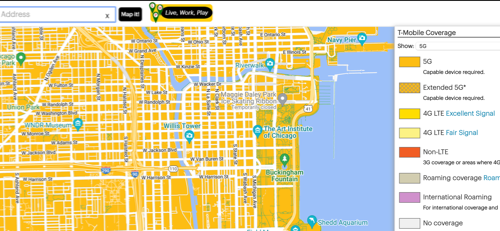
Maps that Show the Nearest Towers
The Federal Communications Commission (FCC) registers most cell towers, so you can find their location online because they are registered in a database and in Google Maps.
If you’re not using one of the providers mentioned above this may be the best way to find your providers’ towers, or other ones that may be in your area. There are several sites that can show you cell phone tower locations in different countries.
Websites With Cell Phone Tower Locations
Cellmapper.net
Arguably the best is Cellmapper. This site is a crowd-sourced cellular tower and coverage mapping service. It is updated constantly, has multiple settings to choose which type of tower and provider you want to search for. It has an intuitive interface and a lot of filtering options.
Scadacore.com
Get an overview of all the cell towers in the United States with Scadacore.com. Data sourced from the FCC website. You can zoom in on the map to your location to find the closest tower.
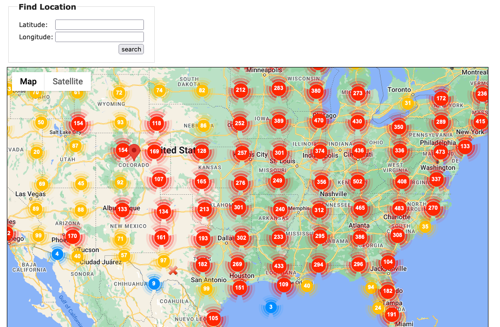
CellReception.com
Go to Cellreception.com enter your city and state to search for towers, registered with the FCC, near you. This site has quite a few filtering options, like searching only for specific carrier’s towers.
AntennaSearch.com
On Antennasearch.com, enter any street address to find a list of every cell tower within a three-mile radius of that address. You can get exact addresses for registered towers as well as specific details including the tower’s height, date of construction, and owner.
Mapmuse
Mapmuse relies on the FCC to get locations of 5G towers in an area. When on this site, use the blue area to search for more options and continue viewing until you spot your location and the tower’s exact address.
The Role of Smartphone Apps To Find 5G Networks
Another easy way to find 5G tower locations is to download one of several smartphone apps that offer free coverage maps. Here’s a little information about the best options out there.
OpenSignal App (iPhone and Android)
Run by crowdsourced data, Opensignal is a free app that shows towers by country and network provider down to street level.
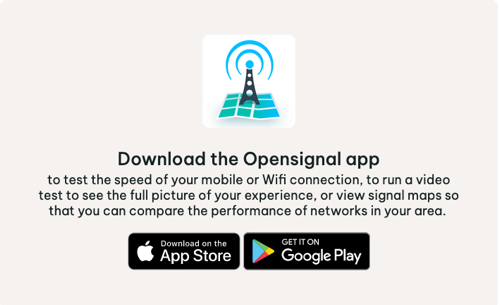
It gives you coverage maps for all the major networks from the data gathered from millions of users. It also does speed tests, signal dashboard, and ping tests.
Tower Locator (for Android users)
This app shows approximate positions of cell towers on maps with buildings as markers on the map to help you find their exact location as well as GPS location. It does request a lot of permissions on your phone, and has some in app-purchases.
A lot of reviews have reported towers being off in accuracy – but hopefully with improvements this app will be a great source of location information.
Network Cell Info Lite (top rated for androids)
With over 55,000 reviews this app measures signal strength, monitors cell carriers, measures cell signals, and has map markers with location and signal info.
Although not designed as a tower locator, its information can help you locate towers near you based on the strength of the signal available.
Websites and Apps With Maps
OK I’ve thrown a lot of options at you – so to sum it up so far; in addition to network providers’ coverage maps, there are several websites and apps that have maps for you to search for 5G tower locations.
Once you have the tower located on the map, the most accurate way to find out where it is, is to use your spectrum analyzer and walk around to actually see the cells.
Your Cell Phone as a Locator
Sometimes, your cell may stick to an old tower location, even if you’re not close to it anymore. Obviously this affects your signal quality but another way you can use this is to locate towers near you.
By turning off and on your phone (resetting it), it will connect to the closest tower. If there isn’t 5G around you then it will not be able to connect to 5G.
Use Your Antenna
You can also use your antenna to find the nearest cell tower. Cell signals are measured in dBm, expressed as a negative number. The closer to zero the reading is, the stronger the cell signal. In your phone’s settings you can find the dBm reading.
Then simply walk around your neighborhood and monitor the values on your phone. The location where the signal is the strongest is a good indication of where a tower is located. Confirm this with the coverage maps in one of the apps – or add your own information to help others.
Monitoring 5G Growth
You may be relieved to know that you do not have 5G near you, so although you are being exposed to many sources EMFs, 5G is currently not one of them.
However, you’ll still want to monitor the growth of 5G for when it does come into your area.
5G is Rapidly Growing
5G is a rapidly growing technology, and network carriers are competing to have the fastest speeds and the most coverage.
Even if you live rural, you’re not safe, although you’re more likely to be exposed to low-band technology. Regularly check the Ookla map, or your carrier’s maps to see if these towers are being built in your area.
How to Prepare For 5G Cell Towers Near Me
While you can’t stop the towers from being put in your area, you can take other actionable steps to ensure your safety. Here are a few tips:
Be active within your local government by sharing your concerns at city and town council meetings.
Write letters and make phone calls to your local government officials. Some cities have taken a stance against 5G. The more people come together, the more likely officials are to listen to your concerns.
EMF Protection Paint, Fabric and Curtains
Protect yourself, your family, and your home. You can paint the interior of your home with EMF protection paint, which completely blocks cell signals from penetrating your walls. You can invest in EMF protective fabric to block the wall facing the tower or 5G shielding curtains.
Clothing, Blankets and Bed Canopies
Alternatively, you can invest in EMF protective clothing, blankets and EMF bed canopies to protect you while you sleep, etc. I highly recommend you get a router that lowers the amount of EMF emissions.
Or if that’s not an option you can buy a wifi router cover guard to protect yourself from your own wireless internet inside your home.
Need Higher Rating To Block 5G
An important thing to note is that many protective products are meant for ELF and lower RF frequencies. If you’re buying something specifically to protect you from 5G signals, then it has to be rated for higher frequencies, like 10MHz to 6GHz in order to block those higher millimeter waves.
Wrapping It Up
5G is growing exponentially and it doesn’t look like this trend is going to stop. Although some people are excited for what this advancement in technology means, others are rightfully concerned over the short-term and long-term health effects 5G will have on us.
I fortunately do not live in an area that has 5G yet, but infrastructure in the area is being built and it won’t be long before the cell towers are up and running.
In order to protect yourself, you have to first locate 5G towers near you using cell tower maps and figure out which kind they are.
The high band, millimeter frequency towers are most concerning and have been tied to mass bird deaths and other very troubling side effects. Do your research and be proactive. This is your life we’re talking about, your family, and your home.
Hopefully in time it will become easier to find these towers, but for now use the links and steps above and take the time to find the towers near you or your company. I hope the methods and tools in article help you find 5g antennas near you.
References
https://blogs.scientificamerican.com/observations/we-have-no-reason-to-believe-5g-is-safe/

